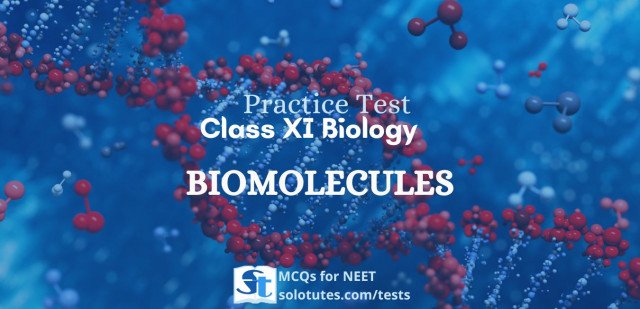Check your Progress and get points for your performance
Login & Start the Test
OR
Start the Test Without Login
OR
Scroll Down to See Questions
Click on Any Option to check right Answer and Explanation.
1 of 25
Q.1 Feedback inhibition of enzymes is affected by which of the following
- enzyme
- substrate
- end products
- intermediate end products
2 of 25
Q.2 An example of competitive inhibition of an enzyme is the inhibition of
- succinic dehydrogenase by malonic acid
- cytochrome oxidase by cyanide
- hexokinase by glucose-6-phosphate
- carbonic anhydrase by carbon dioxide
3 of 25
Q.3 Insulin is made up of _______ and _______.
- glucose and fructose
- glucose and fructose
- fructose and mannose
- mannose and glucose
4 of 25
Q.4 Enzymes increase the rate of reaction by
- lowering activation energy
- increasing activation energy
- increasing temperature and pH
- decreasing temperature and pH
5 of 25
Q.5 Which of the following statements regarding enzyme inhibition is correct?
- Competitive inhibition is seen when a substrate competes with an enzyme for binding to an inhibitor protein
- Non-competitive inhibitors often bind to the enzyme irreversibly
- Competitive inhibition is seen when the substrate and the inhibitor compete for the active site on the enzyme
- Non-competitive inhibition of an enzyme can be overcome by adding large amount of substrate
6 of 25
Q.6 Which of the following is not a pyrimidine?
- Uracil
- Cytosine
- Guanine
- Thymine
7 of 25
Q.7 Hydrolysis of starch occurs with the help of
- Peptidase
- Amylase
- Sucrose
- Lipase
8 of 25
Q.8 Assertion: Arachidic acid is an unsaturated fatty acid Reason: There are one or more double bonds between carbon atoms in unsaturated fatty acids
- Both Assertion and Reason are true and Reason is the correct explanation of the Assertion
- Both Assertion and Reason are true but the Reason is not the correct explanations of Assertion
- Assertion is true, but Reason is false.
- Both Assertion and Reason are false
9 of 25
Q.9 Which of the following influence feedback inhibition of enzyme?
- End product
- External factors
- Enzyme
- Substrate
10 of 25
Q.10 Which of the following is not a polysaccharide?
- Lactose
- Starch
- Glycogen
- Dextrin
11 of 25
Q.11 Inulin is made up of _______ and _______
- glucose and fructose
- glucose and fructose
- fructose and mannose
- mannose and glucose
12 of 25
Q.12 A protein having both structural and enzymatic traits is
- Collagen
- Trypsin
- Myosin
- Actin
13 of 25
Q.13 NADP contains vitamin ______
- B1
- B2
- B3
- B12
14 of 25
Q.14 With reference to enzymes, which one of the following statements is true?
- Apoenzyme = Holoenzyme + Coenzyme
- Coenzyme = Apoenzyme + Holoenzyme
- Holoenzyme = Apoenzyme + Coenzyme
- Holoenzyme = Coenzyme – Apoenzyme
15 of 25
Q.15 Inhibitor binds to the active site of the enzyme. Hence blocking the reaction. This is an example of
- allosteric inhibition
- feedback inhibition
- uncompetitive inhibition
- competitive inhibition
16 of 25
Q.16 The fastest enzyme known is
- DNA polymerase
- carbonic anhydrase
- carbonic dehydrogenase
- DNA ligase
17 of 25
Q.17 Lecithin is a
- polysaccharide
- protein
- nucleic acid
- lipid
18 of 25
Q.18 The minimum amount of energy required to initiate a chemical reaction is called
- enzymatic energy
- activation energy
- substrate energy
- initiation energy
19 of 25
Q.19 Enzymes, vitamins and hormones are common in
- Enhancing oxidative metabolism
- Being synthesised in the body of organisms
- Being proteinaceous
- Regulating metabolism
20 of 25
Q.20 Nitrogenous bases present in DNA
- Adenine, guanine, cytosine, uracil
- Adenine, guanine, cytosine, thymine
- Adenine, thymine, uracil
- Guanine, uracil
21 of 25
Q.21 Metabolic intermediates found in living system which are essential for growth and life is called___________
- Saponins
- Tannins
- Secondary metabolite
- Primary metabolites
22 of 25
Q.22 Enormous diversity of protein molecules is due to
- R groups of amino acids
- Sequence of amino acids
- Peptide bonds
- Amino groups of amino acids
23 of 25
Q.23 Anti-parallel strands of a DNA molecule mean that
- One strand turns anticlockwise
- Phosphate groups at the start of two DNA strands (poles) are in opposite position
- Phosphate groups of two DNA strands at their ends share the same position
- One strand turns clockwise
24 of 25
Q.24 The introduction of t-DNA into plants involves
- Altering the pH of the soil, then heat shocking the plants
- Exposing the plants to cold for a brief period
- Allowing the plant roots to stand in water
- Infection of the plant by Agrobacterium tumefaciens
25 of 25
Q.25 The most common monomer of carbohydrates is
- Sucrose
- Fructose
- Maltose
- Glucose
.png)




















.jpg)







